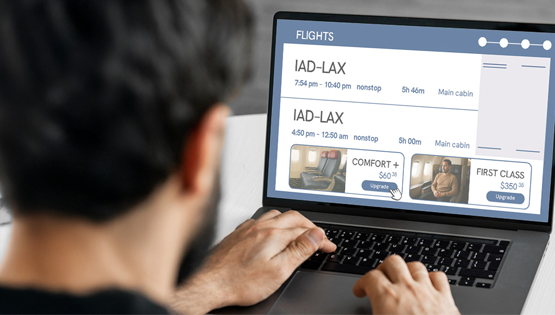This is the third blog article in our series about the airline offer and order life cycle. Modern airline retailing requires transforming to a world of offers and orders to deliver the right offer to the right customer at the right time.
Once an airline has created a compelling offer—complete with prices, products, and pictures—the next step in the offer and order life cycle is distribution: making sure that offer reaches the right customers through the right channels. Just like offer creation, airline distribution is also continuing to evolve. Airlines are
- Creating more and more of their own offers (New Distribution Capability, or Direct Connect), gaining control over content and customization.
- Becoming more sophisticated in their channel strategies—targeting where and how their offers are sold to maximize value.
- Diversifying their payment strategies, enabling greater access and managing the cost and risk of form of payment acceptance effectively
With this shift, it’s critical to understand where distribution is going in the future, what the challenges are, and how to improve distribution efficiency.
First, defining airline offer distribution
Simply put, distributing the offer is the flow of information about an offer from an airline to a buyer. It’s the critical bridge between creation and conversion, connecting airlines to sellers and, ultimately, to buyers—no matter where they shop. With the airline industry’s shift to modern airline retailing, each airline’s distribution strategy is changing to be unique to their needs, business model, and where their consumers choose to shop.
Airline distribution can be described as an airline’s
- Channel strategy, getting the right product to the consumer through the right channels,
- Payment strategy, making sure the consumer can pay for the product, and managing the costs of that form of payment, and
- Control of the offer, where the airline constructs the offer prior to distribution to any third party to sell, also known as direct connect or NDC (New Distribution Capability).
The evolving landscape of airline distribution
Distribution of an airline offer is far more than simply making it available. Accuracy, consistency, and reach are all critical to satisfy today’s flight shoppers, and for this satisfaction to become reality, massive amounts of data need to flow from airlines to sellers to buyers and back again.
Whether through direct channels such as an airline’s website or API, or through indirect channels such as travel agencies and third-party systems, modern distribution is about transmitting more than just the price of a flight. Delivering a full-fledged offer with product attributes, visual content, and more importantly, personalized content tailored uniquely to a shopper’s preferences is critical as the industry transforms into a world of offers and orders. Just as airlines are taking greater control over the offers they create, they’re also taking greater ownership over how those offers get in front of their customers.
Supported by modern standards like NDC, which allows for more direct, detailed, and dynamic exchanges of airline offer information, airlines are increasingly integrating directly with third parties using APIs to have better control over their products. But this connectivity requires coordinated movement of all offer-related data from all sources. This integration also needs a sophisticated approach to channel strategy and payment strategy, as well as a drive to 100% offer creation by the airline.
So, how does ATPCO enable airline offer distribution sophistication?
ATPCO plays a critical role in powering the global airline retailing ecosystem. We have already explored how ATPCO supports offer creation, but ATPCO is also central to distributing offer data—fares, rules, visuals, branded content, ancillaries, and conditions—in consistent, standardized formats. This governance ensures every airline’s intent is preserved across all channels, regardless of how or where the offer is sold.
Here’s how ATPCO supports modern airline offer distribution:
- Channel strategy enablement: Airlines can apply enhanced distribution to fine-tune how their offers appear on different channels to match their commercial strategy. With ATPCO tools like Sales Restrictions (Rules Category 15) and targeted fees (carrier-imposed or offer owner fees), airlines can control who sees what offer, and then tailor price, product, and presentation accordingly.
- Payment strategy sophistication: Airlines can influence purchase behavior by offering flexible payment options and pricing them intelligently. By varying fees (carrier-imposed fees or offer owner fees) based on payment method, they manage cost and risk while using ATPCO’s existing fee structures to implement this differentiation across their order fulfillment networks.
- NDC implementation at scale: As the industry embraces airline-controlled offers through IATA’s NDC standards, ATPCO bridges the gap between new retailing models and legacy systems. Our NDC Solutions Design Team partners with IATA and ARC to ensure this transformation reaches every corner of the distribution landscape. A good example is enabling seller markup through Negotiated Fares (Rules Category 35) in an NDC flow.
- Universal connectivity: Whether an airline pushes offers directly to the buyer or through third-party channels, ATPCO ensures the data flows exactly as the airline intended. From simple components like fares and taxes to full offers, we support broad, accurate distribution across both traditional and modern retailing channels—supporting seamless interoperability across business partners.
Understanding airline offer distribution at a deeper level
Modern airline retailing requires more control, more flexibility, and more insights into how offers are being distributed. As airlines evolve their retailing strategies to deliver more personalized dynamic offers, distribution must evolve too. Creating a great offer isn’t enough. It must appear when, where, and how customers are ready to buy.
That’s why we’re continuing the conversation around airline offer distribution in our upcoming webinar on 3 June, where we’ll discuss and unpack real-world strategies, solutions, and results so you can optimize your offer distribution for today and tomorrow.
Watch the offer distribution webinar


